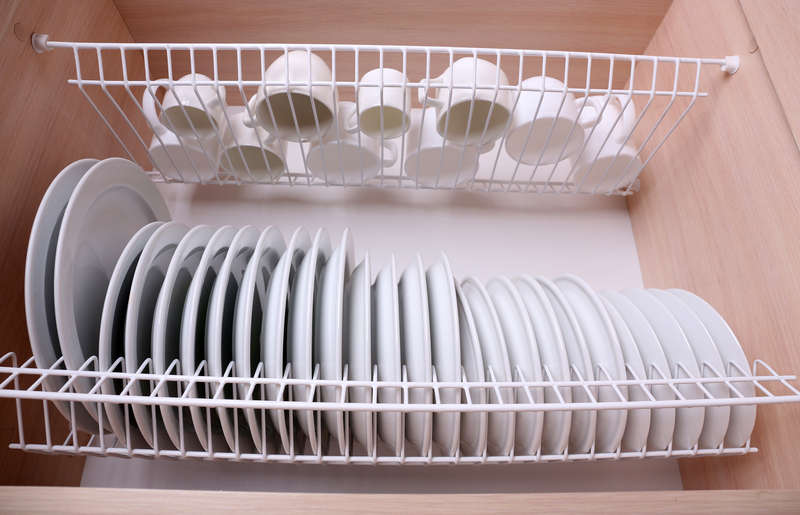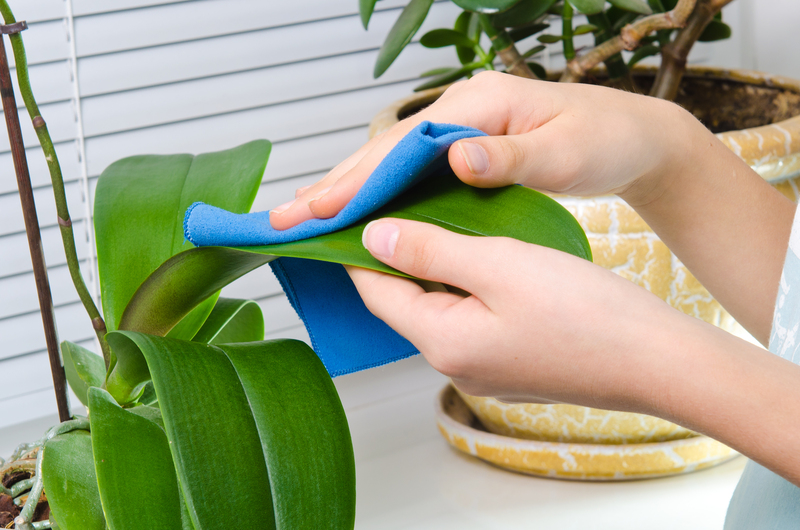Achieve Shiny Window Sills: A Mould Cleaning Tutorial
Posted on 23/08/2025
Achieve Shiny Window Sills: A Mould Cleaning Tutorial
Are your window sills losing their luster due to persistent mould or mildew? Shiny and spotless window sills not only enhance your home's appearance but also contribute to a healthier living environment. This comprehensive mould cleaning guide will walk you through effective methods for restoring your sills to their sparkling clean condition. Let's discover expert tips, eco-friendly solutions, and step-by-step instructions to keep your window sills gleaming and mould-free.

Why Clean Mould from Window Sills?
Before diving into the best techniques for removing mould from window sills, it's essential to understand why mould removal is crucial:
- Health benefits: Mould can trigger allergies, respiratory problems, and even infections.
- Preservation: Mould damages paint, wood, silicone, and other window sill materials.
- Home value: Shiny and well-maintained window sills boost property value and curb appeal.
- Odor control: Eliminating mould prevents musty odours in your home.
Regular cleaning is the key to maintaining bright, mould-free window sills.
What Causes Mould on Window Sills?
Mould thrives on window sills due to a combination of excess moisture, poor ventilation, and organic debris (like dust or pollen). Common factors include:
- Condensation from warm interior air hitting cold glass
- Leaky windows or insufficient caulking
- Poor air circulation in humid areas
- Neglected cleaning routines
To achieve shiny window sills that last, you'll need to address both cleaning and prevention strategies.
Essential Supplies for Cleaning Mouldy Window Sills
Gather Your Cleaning Toolkit
Using the right cleaning tools ensures thorough mould removal and helps protect your window sills from damage. Here's what you'll need:
- Protective gloves (mould spores can irritate the skin)
- Face mask (to avoid inhaling mould spores)
- Scrub brush or old toothbrush (for smaller crevices)
- Microfiber cloths (for gentle but effective wiping)
- Spray bottle
- Bucket
- Old towels for catching drips
Choosing the Right Cleaning Agents
- White vinegar: a natural and powerful mould killer
- Baking soda: neutralizes odours and adds scrubbing power
- Hydrogen peroxide (3%): disinfects and removes stains
- Mild dish soap: helps lift grime and mould from surfaces
- Commercial mould remover (for persistent problems)
Tip: Avoid using bleach on wood window sills--it can cause fading or damage.
Step-by-Step Mould Removal: Get Your Window Sills Sparkling
Follow this detailed tutorial to achieve those shiny, mould-free sills you're dreaming of:
Step 1: Prep the Area
- Open nearby windows or doors to improve ventilation and help dry the sill.
- Remove curtains, blinds, or plants from the window area.
- Lay a towel beneath the sill to absorb drips and catch debris.
- Put on gloves and a mask for safety.
Step 2: Dry Clean Loose Debris
- Use a dry microfiber cloth or soft brush to wipe away dust, cobwebs, or loose dirt.
Step 3: Apply the Mould Cleaning Solution
Create your DIY mould cleaning solution:
- Natural method: Pour equal parts white vinegar and water into a spray bottle.
- For stubborn stains: Use undiluted vinegar or a 3% hydrogen peroxide solution.
- Generously spray the affected window sill areas.
- Let the solution sit for 10-20 minutes--this allows it to penetrate and kill mould spores.
Step 4: Scrub Away the Mould
- Gently scrub the surface with your brush or an old toothbrush.
- For narrow spaces or corners, use cotton swabs dipped in the cleaning solution.
- For textured surfaces, sprinkle a little baking soda for extra abrasion before scrubbing.
Step 5: Rinse and Wipe Clean
- Use a clean, damp microfiber cloth to wipe away any lingering mould and cleaning residue.
- Rinse the cloth in fresh water frequently to avoid spreading spores.
Step 6: Dry Thoroughly
- Pat the area with paper towels or a dry cloth.
- Let the window sill air-dry fully--use a fan or hair dryer for faster drying if needed.
Step 7: Shine and Protect
- For extra shine and a protective barrier, rub a small amount of mineral oil onto painted or wooden sills.
- Wipe away excess for a glossy, streak-free finish.
Special Tips for Different Window Sill Materials
Wooden Window Sills
- Do not oversaturate with liquid--wood absorbs moisture, which may worsen mould.
- Avoid bleach, which can discolor or weaken wood grains.
- Finish with a wood polish or conditioner after cleaning and drying.
Plastic or Vinyl Window Sills
- These materials tolerate vinegar, hydrogen peroxide, or mild commercial cleaners.
- Buff gently with a soft cloth for a shiny, like-new appearance.
Stone or Marble Window Sills
- Avoid acidic cleaners like vinegar, which can etch natural stone.
- Use a pH-neutral or stone-specific cleaner and soft brush.
- Seal stone sills periodically to keep them mould and stain resistant.
How to Prevent Mould from Returning
Getting your window sills shining is one thing--keeping them that way is another! Prevent future mould growth with these practical strategies:
- Control moisture: Use a dehumidifier, especially in humid climates.
- Improve ventilation: Keep windows open when possible and use exhaust fans in kitchens and bathrooms.
- Insulate windows: Well-sealed windows reduce condensation buildup.
- Regularly clean sills and window tracks to remove dust and organic matter.
- Keep window coverings dry--wash curtains and blinds frequently.
What to Do with Severe or Recurring Mould
If you regularly notice thick black or green mould patches on your window sills, consider these steps:
- Check for leaks: Hidden water ingress or damaged window flashing could be the culprit.
- Remove and replace sealant: Cracked or mouldy caulk should be scraped away and resealed.
- Consult a professional: Extensive or recurring mould may require attention from a mould remediation specialist.
- Upgrade windows: In older homes, installing double glazing can reduce condensation risk.
DIY Mould Cleaning Alternatives
Tea Tree Oil Cleaning Solution
- Mix 1 teaspoon of tea tree oil with a cup of water in a spray bottle.
- Spray directly onto the mould, let sit for 30 minutes, then wipe away.
Lemon Juice for Shine
- Cut a lemon and rub it directly onto stubborn stains before wiping clean.
- For added shine, finish with a few drops of olive oil buffed with a soft cloth.
Natural remedies are ideal for those who prefer eco-friendly home cleaning.

Frequently Asked Questions about Mould and Window Sill Cleaning
Is vinegar safe for all window sill surfaces?
Vinegar is safe for most materials except natural stone (like marble or granite), where it may cause etching. Test in a hidden area first.
How often should I clean my window sills?
Wipe down window sills at least once per month. During rainy or humid periods, check and clean more frequently.
Can I paint over mould instead of cleaning it?
Never paint over mould! This will trap moisture and worsen the problem. Always clean and dry completely first.
What if the mould keeps coming back?
Address possible hidden leaks, ventilation issues, or high indoor humidity. Persistent mould often signals an underlying moisture problem.
The Bottom Line: Enjoy Sparkling, Mould-Free Window Sills
Achieving and maintaining shiny window sills free from mould is easier than you think--especially with the right cleaning solutions and techniques. By tackling mould as soon as it appears, establishing preventative measures, and using the correct products for your specific window sill material, you'll protect your family's health and boost your home's beauty.
Take time to inspect your window sills regularly, and they'll reward you with enduring shine and freshness. Don't let mould take over your space! Follow this comprehensive mould cleaning tutorial, and enjoy a brighter, healthier home.
Key Steps Recap for Shiny Window Sills
- Remove debris and dust before starting.
- Choose the right mould cleaner for your sill material.
- Scrub gently and let your chosen solution work.
- Rinse, dry, and protect for a shiny finish.
- Inspect and clean regularly to prevent mould's return.
Ready to enjoy those spotless, gleaming window sills? Try these tips today and transform your windows into a true highlight of your home!




